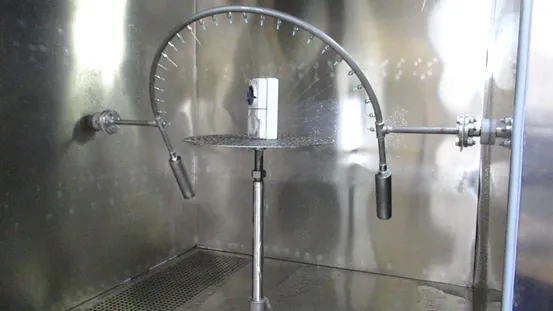SAE J1455 IP Testing for Truck Electrical Components
The SAE J1455 standard specifies a method for determining the ingress protection ratings of truck electrical components. The test aims to evaluate the ability of these components to withstand exposure to dust and water, ensuring they perform reliably under harsh conditions found in commercial vehicle environments.
Truck electrical systems are subject to various environmental stresses that can compromise component integrity. These stresses include frequent temperature changes, mechanical vibrations, and continuous operation with varying loads. The SAE J1455 test is designed to mimic these real-world conditions, providing a robust assessment of the durability and reliability of truck electrical components.
The testing process involves exposing the component to different combinations of water jets and dust chambers to simulate environmental challenges. The standard defines nine levels (IP01 through IP69K) based on the amount of dust and water ingress allowed. The test is particularly important for ensuring that critical components such as engine control units, brake systems, and lighting assemblies operate safely and effectively under all conditions.
For quality managers and compliance officers, understanding SAE J1455 is crucial to ensure that truck electrical components meet the necessary standards before being integrated into vehicles. R&D engineers benefit from this test by identifying potential weaknesses in design or manufacturing processes early on. Procurement teams rely on these tests to verify supplier performance and maintain supply chain quality.
The SAE J1455 IP rating system is widely recognized for its comprehensive approach to environmental testing, making it an essential tool for the trucking industry. By adhering to this standard, manufacturers can ensure that their products are not only reliable but also capable of withstanding the rigors of daily operations.
One key aspect of SAE J1455 IP testing is the use of a water jet apparatus designed specifically for high-pressure and high-temperature conditions. This equipment allows for precise control over the amount and type of water exposure, ensuring accurate results. For dust ingress tests, a controlled environment chamber simulates varying levels of particle contamination.
Testing procedures typically involve submerging the component in a water bath or subjecting it to direct water jets from multiple angles. Dust testing may require placing the component inside a chamber where particles are introduced at different rates and intensities. Both tests are conducted under controlled temperature conditions to simulate real-world scenarios.
The acceptance criteria for SAE J1455 IP ratings vary depending on the specific requirements of each application. Generally, components rated IP67 or higher are considered highly reliable for use in challenging environments. However, certain critical systems may require even stricter standards such as IP69K, which ensures resistance to high-pressure and hot water washdowns.
Compliance with SAE J1455 is not only important from a regulatory standpoint but also helps build trust among customers who rely on the reliability of truck electrical components. By adhering to these standards, manufacturers can enhance their reputation for quality and innovation within the industry.
Applied Standards
The SAE J1455 standard is closely aligned with international standards such as ISO 20652 for general-purpose electrical enclosures and IEC 60529 for protection ratings of electrical enclosures. These standards provide a common framework for assessing the ingress protection levels of truck electrical components.
When conducting SAE J1455 IP tests, it is essential to follow the guidelines outlined in these referenced documents. The standard specifies detailed procedures for both water and dust testing, ensuring consistent results across different laboratories. Compliance with these standards helps maintain uniformity in quality assurance practices throughout the industry.
The SAE J1455 test protocol includes specific requirements for equipment calibration, environmental control, and data recording to ensure accurate assessment of ingress protection levels. By adhering strictly to these procedures, testing labs can provide reliable certification that meets or exceeds customer expectations.
Quality and Reliability Assurance
The SAE J1455 IP test plays a crucial role in the quality assurance process for truck electrical components. By subjecting each component to rigorous environmental challenges, manufacturers can identify potential issues early on, allowing for corrective actions before mass production begins.
For R&D engineers, this testing offers valuable insights into material selection and design improvements. It helps them understand how different factors such as coating type or housing structure affect overall durability. Engineers can use the results of these tests to optimize future designs based on proven methodologies.
Procurement teams also benefit significantly from SAE J1455 IP testing by ensuring that suppliers meet stringent quality standards before being considered for contracts. This reduces risks associated with subpar materials or unreliable manufacturing processes, leading to more dependable products overall.
In addition to improving product performance, adherence to SAE J1455 promotes safer operations within the trucking industry. Reliable electrical components are less likely to fail under extreme conditions, reducing maintenance costs and potential hazards for drivers and passengers alike.
Use Cases and Application Examples
Engine control units (ECUs): Ensuring accurate fuel injection and emissions controls even in harsh weather conditions.
Brake system modules: Guaranteeing dependable braking performance through all seasons, including heavy rainfalls or snowy environments.
Led headlights: Maintaining visibility for drivers during nighttime driving in various lighting conditions.
Sensors and actuators: Providing precise measurements and responses regardless of external factors like humidity or temperature fluctuations.
Power distribution units: Ensuring stable power supply to all vehicle subsystems amidst frequent environmental stressors.
On-board diagnostic systems: Detecting faults accurately while adhering to strict IP ratings for protection against contaminants.
The SAE J1455 IP test is particularly beneficial in cold regions where trucks often operate under severe weather conditions. It ensures that critical components remain functional throughout the year, minimizing downtime and enhancing overall vehicle performance.





